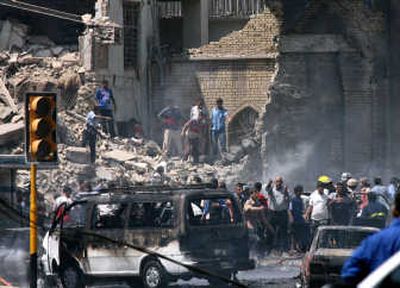Iraq truck blast suggests shift

BAGHDAD – Thousands of U.S. troops waged a new offensive against al-Qaida in Iraq north of the capital on Tuesday, focusing in particular on the extremist group’s bomb-making facilities, while at least 60 people were killed and more than 85 wounded in a massive suicide truck blast at a Baghdad mosque, U.S. and Iraqi officials said.
American officials have said that the majority of car and truck bombs are built outside the capital by members of al-Qaida in Iraq, the Sunni-dominated insurgent group. But a preliminary investigation showed that the truck used in Tuesday’s blast was rigged with TNT just 1,500 yards away from where it exploded, near the Shiite al-Khilani Mosque.
If that proves to be the case, it would mean that al-Qaida in Iraq has shifted strategies once again, this time in reaction to increased security efforts meant to control access to Baghdad.
In an interview on state-run al-Iraqiya television, Brig. Gen. Qassim Atta, an Iraqi spokesman for the four-month-old Baghdad security plan, suggested as much on Tuesday, saying that insurgents are now building car bombs inside Baghdad, hoping to avoid driving through the city and being detected at newly erected security checkpoints.
The stepped-up military operations in and around Baghdad were made possible by the deployment of almost 28,500 additional U.S. troops over the past four months. The buildup is meant to curb violence in Baghdad, but U.S. officials and military analysts have long warned that its success would hinge on pacifying the belt around the city.
The newest U.S. operation, called “Arrowhead Ripper,” is taking place in Diyala province, a mixed Shiite-Sunni-Kurdish area bordering Iran that recently has become the most violent area in Iraq outside of the capital. U.S. officials said the offensive is expected to last at least 30 to 60 days.
About 10,000 soldiers are involved in Arrowhead Ripper, making it one of the largest military operations since the Iraq war began more than four years ago. It is focused around the city of Baqouba, located about 35 miles northeast of Baghdad. The area has become a key stronghold for al-Qaida in Iraq, a flash point for sectarian and ethnic violence, and a transit point for money, weapons and munitions from Iran, U.S. officials say.
Lt. Col. Joseph Davidson, executive officer of the 2nd Infantry Division, said in a telephone interview that about 4,000 U.S. combat forces began flushing out insurgents in the western area of Baqouba, where there was an “entrenched population” of al-Qaida fighters. He said the group had set up fighting positions across the city, lacing its streets with powerful “deep-buried” bombs capable of destroying U.S. armored vehicles.
In the first 24 hours, Davidson said, U.S. forces killed at least 30 insurgents. The U.S. military reported one soldier was killed and two were wounded during the operation when an explosion occurred near their vehicle.
Tuesday’s suicide attack in Baghdad was the 11th bombing in Iraq this year to result in more than 50 fatalities, although there were conflicting reports about the number of casualties. The Reuters and Associated Press news agencies both reported 78 dead and more than 200 wounded; Atta, the spokesman for the Baghdad security plan, said in a telephone interview that at least 60 were killed and more than 85 were wounded; the U.S. military, which said it had units nearby that rendered aid, said that 35 people were killed and 65 were wounded.